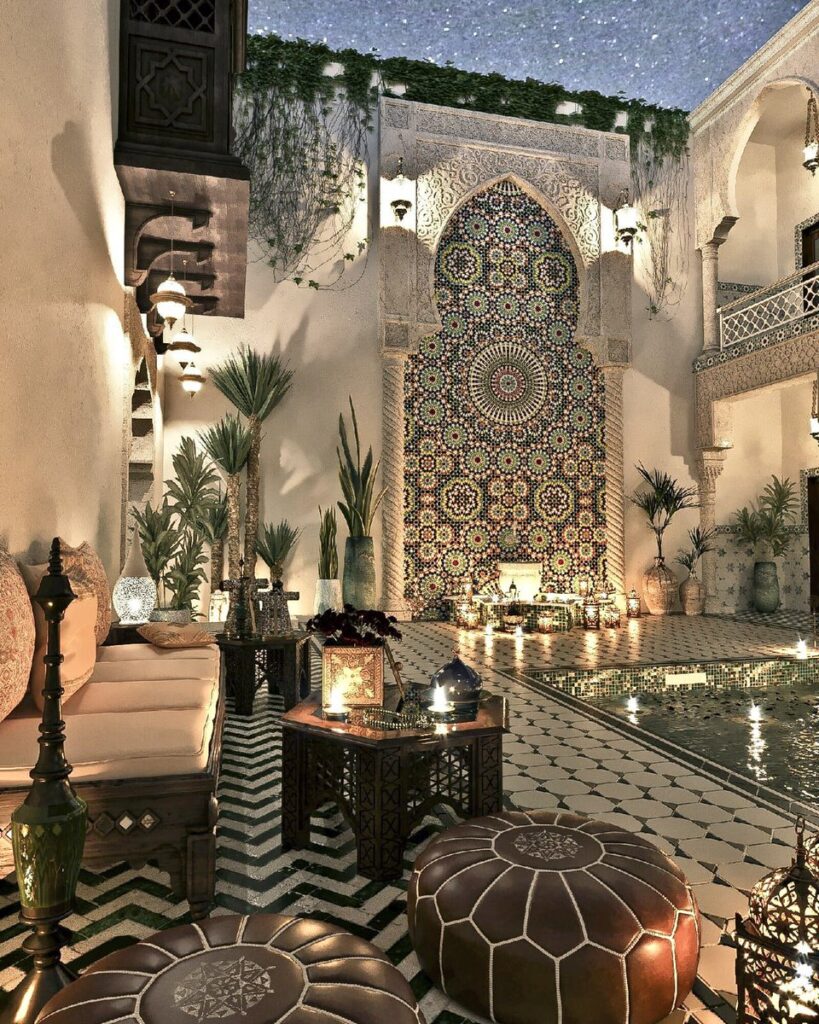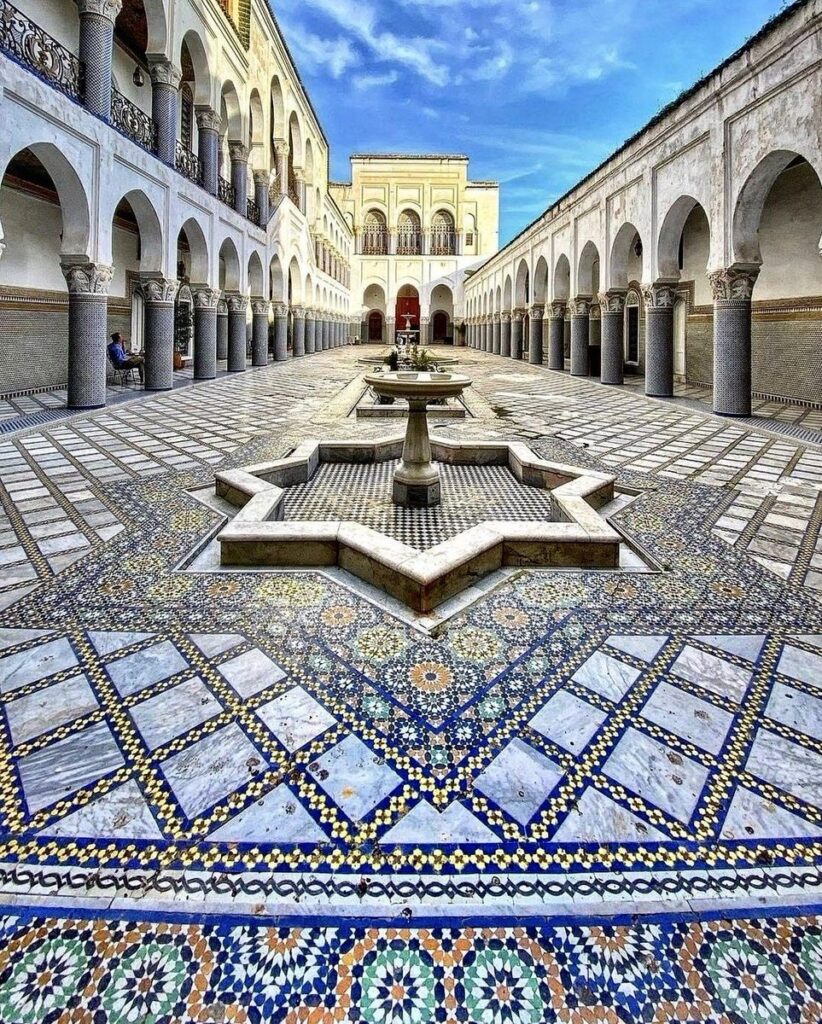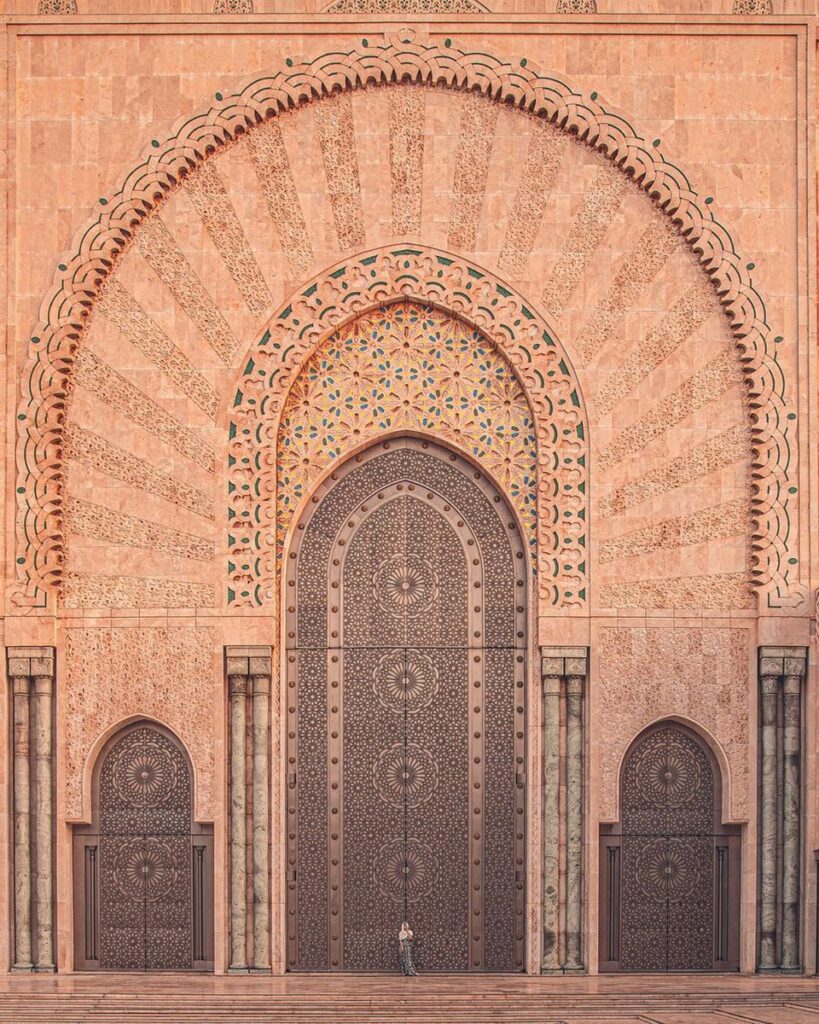Exploring the Rich Islamic Design and Religious Practices of Morocco
Morocco, with its rich history and cultural heritage, stands as a treasure trove for enthusiasts of Islamic design. From the intricate details of traditional architecture to the vibrant patterns adorning everyday items, the influence of Islamic design is omnipresent, offering a captivating journey through the country’s artistic soul.
Moroccan design embraces a vibrant palette, rich textures, and graceful lines, combining influences from North African, Mediterranean, and Islamic aesthetics. This unique fusion creates a visually striking aesthetic that has served as a wellspring of inspiration for artists and designers globally.
Mosques and Minarets: The grand mosques of Morocco, such as the Hassan II Mosque in Casablanca and the Koutoubia Mosque in Marrakech, are architectural marvels adorned with exquisite geometric patterns, intricate tilework, and delicate calligraphy. These sacred spaces serve as both places of worship and showcases of Islamic artistry.
Madrasas and Medersas: Morocco’s historic madrasas and medersas, such as the Ben Youssef Madrasa in Marrakech and the Bou Inania Madrasa in Fes, are renowned for their stunning architecture and intricate ornamentation. These educational institutions feature intricately carved stucco, vibrant mosaic tiles, and elegant arches, showcasing the beauty of Islamic design.
Palaces and Royal Residences: Morocco’s royal palaces, including the magnificent Bahia Palace in Marrakech and the opulent Royal Palace in Fes, are veritable showcases of Islamic design and craftsmanship. Elaborate zellige tilework, intricately carved woodwork, and sumptuous textiles adorn these regal residences, reflecting the country’s royal heritage and cultural sophistication.
Architectural Marvels:

Moroccan cities boast a myriad of architectural wonders reflecting Islamic design principles. The iconic geometric patterns, intricate tilework, and ornate arches found in structures like the Alhambra in Granada, Spain, have inspired many Moroccan architectural gems. The Medersa Ben Youssef in Marrakech, for instance, showcases the exquisite blending of geometric precision and aesthetic beauty, creating a serene and harmonious space for reflection and study.
Zellige Tiles:
Zellige, a form of mosaic tilework, is a hallmark of Islamic design found extensively in Moroccan architecture. The meticulous craftsmanship involved in creating these colorful, geometric patterns is awe-inspiring. From intricate geometrical compositions to flowing floral designs, Zellige tiles adorn mosques, palaces, and homes, providing a visual feast for those who appreciate the beauty of precision and symmetry.

Islamic Calligraphy:
Islamic calligraphy, another integral aspect of Islamic art, is widely embraced in Morocco. The elegant Arabic script often decorates mosques, monuments, and everyday objects. The Kufic and Maghrebi scripts, in particular, are prominent styles seen in various contexts, conveying both religious texts and artistic expressions.
Textiles and Patterns:

Moroccan textiles showcase a vibrant array of patterns influenced by Islamic design. Traditional carpets, blankets, and garments often feature geometric shapes, stylized floral motifs, and intricate designs that echo the aesthetics of Islamic art. These textiles not only serve functional purposes but also serve as expressions of cultural identity and artistic flair.
Courtyards and Gardens:
Islamic design in Morocco extends beyond buildings and textiles to encompass outdoor spaces. Courtyards and gardens are meticulously designed to provide tranquility and beauty. Elements such as fountains, tiled pathways, and lush greenery contribute to creating serene havens that reflect Islamic design principles of balance and harmony with nature.
Calligraphy and Illumination: Islamic calligraphy, with its elegant script and profound meaning, is widely used as a decorative element in Moroccan design. From Quranic verses inscribed on mosque walls to ornate manuscripts adorning palaces, calligraphy adds a spiritual dimension to Morocco’s artistic heritage.
Textiles and Carpets: Moroccan textiles, including colorful rugs, intricately embroidered fabrics, and luxurious silk brocades, are prized for their beauty and craftsmanship. Traditional textile techniques such as weaving, embroidery, and dyeing have been passed down through generations, preserving Morocco’s textile heritage.
Metalwork and Filigree: Moroccan metalwork, known for its intricate filigree designs and delicate craftsmanship, adorns doors, windows, lamps, and furniture. Brass, copper, and silver are commonly used metals, shaped and embellished with intricate patterns inspired by Islamic geometry and nature.
Woodwork and Carving: Moroccan woodwork, characterized by intricate carving and geometric motifs, is a prominent feature of Islamic design. From elaborately carved doors and window screens to intricately patterned ceilings and friezes, woodwork adds warmth and texture to Morocco’s architectural landscape.

Conclusion:
Discovering Islamic design in Morocco is a journey through time and culture, where every intricate detail tells a story of craftsmanship, spirituality, and artistic expression. From the grandeur of architectural marvels to the subtlety of everyday items, Morocco’s embrace of Islamic design is a testament to the enduring beauty and significance of this rich artistic tradition.
Exploring the Rich Religious Practices of Morocco
Introduction:
Morocco, a North African gem with a diverse cultural heritage, boasts a fascinating tapestry of religions that have coexisted for centuries. This nation, situated at the crossroads of Africa and the Arab world, is not only celebrated for its breathtaking landscapes and vibrant traditions but also for its harmonious blend of religions. In this article, we will delve into the religious mosaic that defines Morocco, exploring the major faiths that have shaped the spiritual landscape of this enchanting country.
Islam – The Dominant Faith:
Islam stands as the predominant religion in Morocco, shaping the nation’s culture, traditions, and daily life. Nearly 99% of Moroccans identify as Muslims, primarily following the Sunni branch of Islam. The Maliki school of Islamic jurisprudence holds sway in Morocco, influencing the legal and social frameworks of the country. Mosques dot the landscape, and the hauntingly beautiful call to prayer echoes through the bustling medinas, underscoring the profound influence of Islam on Moroccan society.
Amazigh Traditions and Animism:
Before the arrival of Islam, Morocco was home to the indigenous Amazigh (Berber) people, who had their own set of spiritual beliefs. Many Amazigh communities integrated aspects of animism into their practices, venerating natural elements and ancestral spirits. Although Islam has largely eclipsed these pre-Islamic beliefs, traces of Amazigh traditions can still be found in various cultural practices, folklore, and festivals, highlighting the resilience of Morocco’s diverse religious heritage.
Judaism – A Historical Presence:
Morocco has a rich Jewish history dating back centuries. Before the mass emigration of Jewish communities in the mid-20th century, Morocco was home to a significant Jewish population. Cities like Marrakech, Fes, and Casablanca were once vibrant centers of Jewish life. Today, remnants of this heritage can be explored in the well-preserved Jewish quarters, synagogues, and cemeteries scattered across the country.
Religious Tolerance:
One of the remarkable aspects of Morocco’s religious landscape is the longstanding tradition of religious tolerance. The country has been a haven for coexistence, where people of different faiths have lived side by side for generations. This tradition is deeply embedded in Moroccan culture and is a testament to the nation’s commitment to pluralism and diversity.
Religious Festivals and Celebrations:
Morocco’s religious diversity is showcased in its array of colorful festivals and celebrations. From the fervor of Ramadan, the Islamic holy month of fasting, to the vibrant festivities of Eid al-Fitr and Eid al-Adha, the nation resonates with the joyous spirit of religious observances. Additionally, Moroccan Jews celebrate festivals such as Passover and Rosh Hashanah, contributing to the mosaic of religious celebrations that enrich the cultural fabric of the country.
Conclusion:
Morocco’s religious landscape is a testament to the nation’s rich history and cultural complexity. The coexistence of Islam, Amazigh traditions, and Judaism has created a diverse and harmonious tapestry that defines Morocco’s spiritual identity. As the country continues to evolve, it remains a shining example of how different faiths can thrive together, weaving a narrative of unity in diversity that is as captivating as the landscapes that grace this North African jewel.
Read More Explore Morocco’s Governmental System and The Red City: Unraveling its Origins.

